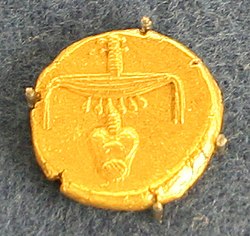Gold (hieroglyph)
| ||
| Gold in hieroglyphs | ||
|---|---|---|
Look up 𓋞 in Wiktionary, the free dictionary.
The
Fivefold Titulary
names of the Egyptian pharaoh.

In its determinative usage, it identifies any precious metal, [1] and as an ideogram in "gold" specifically (Egyptian nbw, whence Coptic ⲛⲟⲩⲃ nūb).[2][3]
The hieroglyph represents a large gold and pearl necklace.
Derived forms
Three variants of the gold hieroglyph are
ligatured with another hieroglyph:[7]
|
| |
Foot
).| |
was scepter
-("uas scepter"), for "electrum", dj'm.Usage
Horus-of-Gold name
12th dynasty
pectoral, featuring twice a combination of the Horus falcon with the gold hieroglyphOne of the older uses of the gold hieroglyph is for the Horus-of-Gold,
name. Also known as the Golden Horus Name, this form of the pharaoh's name typically featured the image of a Horus falcon perched above /or beside the hieroglyph for gold.
| |
The meaning of this particular title has been disputed. One belief is that it represents the triumph of
Seth
, as the symbol for gold can be taken to mean that Horus was "superior to his foes". Gold also was strongly associated in the ancient Egyptian mind with eternity, so this may have been intended to convey the pharaoh's eternal Horus name.
Similar to the
Fivefold Titulary Nebty name, this particular name typically was not framed by a cartouche or serekh. It always begins with the depiction of the horus falcon perched above a representation of the sun
-(hieroglyph).| |
The combination of the Horus falcon and the gold hieroglyph is frequently found on Ancient Egyptian pectorals (see image).
Gold

(Obverse)
In the
Old Egyptian Palermo Stone
inscription (late 24th or early 23rd century BC),
the hieroglyph is used in the phrases "first counting of gold" and "collar of gold".
One spelling of the word "gold", nbw, in the Egyptian language, uses the melted nugget determinative,
| |
(a small circle), and the plural strokes (3-strokes).
Late Period coinage

One of the few coins minted for
30th Dynasty
. The reverse of the gold stater shows a horse reared up on its hind legs. The obverse has the two hieroglyphs for nfr and nb: "Perfect gold", or a common-era term: 'Fine'-gold.
-
Goddess Nephthys upon the Gold hieroglyph, sarcophagus of Ramesses III
See also
Wikimedia Commons has media related to Collar of gold (hieroglyph).
- Gardiner's Sign List#S. Crowns, Dress, Staves, etc
- List of Egyptian hieroglyphs
- Nebu
References
- Betrò, Maria Carmela. ISBN 0-7892-0232-8)
- Budge, The Rosetta Stone, ISBN 0-486-26163-8)
- Schumann-Antelme, and Rossini, 1998. ISBN 1-4027-0025-3)



